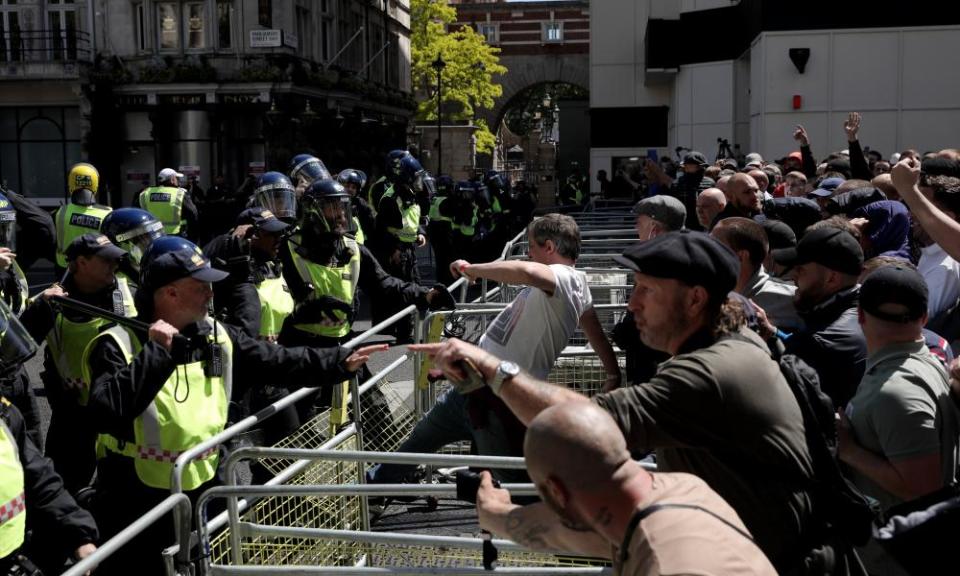Johnson whips up fear of the leftwing mob, but the true threat is from the right

If two elderly Conservative canvassers had been hospitalised by members of Momentum, you can be sure the incident would make the outraged front pages of national newspapers. Indeed, during the last general election campaign, an alleged punch thrown by a Labour activist at a Tory adviser received wide attention from our broadcast media: it was only later when a video emerged exposing the incident as a lie that several journalists issued mea culpas about their reporting.
During the course of the 2019 general election, however, two Labour canvassers in their 70s were hospitalised after separate unprovoked attacks. The intent seemed clear: one assailant was screaming “Marxists” at a group of canvassers before lunging at a female Labour supporter. But you are unlikely to have heard about these incidents, because they received little coverage.
It is worth reflecting on this in light of comments by the prime minister yesterday, in which he compared Labour activists and “Momentum trolls” to the far-right extremists who stormed the Capitol in Washington DC two weeks ago. He further claimed that today’s push by Labour to keep the universal credit uplift would incite “the worst kind of hatred and bullying”. Here is the rhetoric of restoring civility to politics at its most cynical: Tory MPs voting to raid the pockets of the poor are victims, while those challenging them on social media are the bullies. It should not need saying, but being a powerful politician is not a protected characteristic.
But the comments reveal something else: how the British left has been systematically demonised as a violent, dangerous rabble, thus obscuring the real threat, which comes from the political right. It isn’t just Conservatives and their media outriders who have promoted this grotesque fiction, but many commentators who would style themselves as “moderates” and “liberals”. Writing in the Sun, the former Labour MP Ian Austin claimed that the hard-left and Trump were “two sides of the same coin”, suggesting that a US-style assault on parliament could happen here with a “leftie mob”.
It is less than five years since the Labour MP Jo Cox was murdered by a far-right terrorist. Another far-right terrorist is behind bars after plotting to kill the Labour MP Rosie Cooper with a machete. Another far-right terrorist – who ploughed his van into a crowd of Muslim worshippers, killing one – drove to London with the intention of murdering Jeremy Corbyn and Sadiq Khan. Far-right terror is a growing menace: last October, MI5 reported that nearly a third of terror plots disrupted since 2017 were organised by far-right extremists.
We don’t need to imagine what the British equivalents of those Capitol Hill extremists looked like, because they long assembled outside our country’s own legislature. In early 2019, the anti-Brexit former Conservative MP Anna Soubry was targeted by yellow vest-wearing extremists near parliament, and indeed I, too, was mobbed by the same crowd, days before again being surrounded by far-right activists in Trafalgar Square who screamed homophobic abuse while trying to punch me. The ringleader of the first incident is a self-described Conservative voter who led another mob which surrounded Corbyn’s entourage in Salford in the autumn of 2019, and who more recently was given a restraining order after harassing a female journalist. After I was beaten up in 2019 by a far-right extremist now serving a prison sentence, it was notable that the incident was somehow not placed in the context of the menace of political violence in contemporary Britain.
While the left as a whole is held to account for utterances made by anonymous accounts on Twitter, the same standard is not applied to far more sinister phenomena on the right. Before the 2019 election, crowds of far-right extremists outside parliament alternated chants of “We love you Boris, yes we do” with yelling “We’ve got a lamppost just for you” at leftwing protesters, lunging at those of us necessarily protected by stand-in bodyguards as we made our way to our demonstration. Neither has there been meaningful discussion about the repeated heartfelt endorsements of Johnson by the violent thug Tommy Robinson, or that the leader of far-right extremists Britain First, Paul Golding, claimed he’d joined the Conservatives to “help solidify Boris Johnson’s control on the leadership, so we can achieve Brexit and hopefully cut immigration and control radical Islam”.
That much of the press focuses instead on a phantom threat from the left is perhaps unsurprising. Most newspapers not only support the Conservatives, but their rhetoric – including inflammatory talk of “traitors” and “enemies of the people”, the relentless portrayal of the left as Britain-hating terrorist-sympathising extremists – plays a crucial role in radicalising rightwing thugs.
Last year, it was reported that trust in the media had most dramatically collapsed among leftwing voters. This is understandable: their views are largely unrepresented in Britain’s media landscape, and they resent not just newspapers, but broadcasters who will, as we’ve seen, make huge amounts of noise about a non-existent punch by a Labour activist but stay almost silent about rightwing violence. People on the left then take to the one platform where they do have a voice – social media – to express their frustration, in turn causing consternation among commentators who too often elide critique with dangerous abuse.
That is how we end up with the grotesque sight of a Conservative prime minister feeling emboldened to dispute criticisms of failing to provide adequate support for vulnerable families by claiming it incites a vicious leftwing mob. The spectre of such a mob has been conjured up repeatedly by the right and “centre” alike: all the while it dangerously deflects from the main threat, which by any objective measure comes from the right itself.
Owen Jones is a Guardian columnist

 Yahoo Movies
Yahoo Movies 